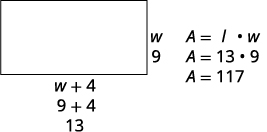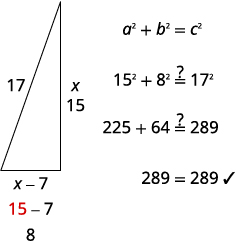Factoring
Polynomial Equations
Learning Objectives
By the end of this section, you will be able to:
- Use the Zero Product Property
- Solve quadratic equations by factoring
- Solve equations with polynomial functions
- Solve applications modeled by polynomial equations
Before you get started, take this readiness quiz.
We have spent considerable time learning how to factor polynomials. We will now look at polynomial equations and solve them using factoring, if possible.
A polynomial equation is an equation that contains a polynomial expression. The degree of the polynomial equation is the degree of the polynomial.
A polynomial equation is an equation that contains a polynomial expression.
The degree of the polynomial equation is the degree of the polynomial.
We have already solved polynomial equations of degree one. Polynomial equations of degree one are linear equations are of the form ![]()
We are now going to solve polynomial equations of degree two. A polynomial equation of degree two is called a quadratic equation. Listed below are some examples of quadratic equations:
The last equation doesn’t appear to have the variable squared, but when we simplify the expression on the left we will get ![]()
The general form of a quadratic equation is ![]() with
with ![]() (If
(If ![]() then
then ![]() and we are left with no quadratic term.)
and we are left with no quadratic term.)
An equation of the form ![]() is called a quadratic equation.
is called a quadratic equation.
To solve quadratic equations we need methods different from the ones we used in solving linear equations. We will look at one method here and then several others in a later chapter.
Use the Zero Product Property
We will first solve some quadratic equations by using the Zero Product Property. The Zero Product Property says that if the product of two quantities is zero, then at least one of the quantities is zero. The only way to get a product equal to zero is to multiply by zero itself.
If ![]() then either
then either ![]() or
or ![]() or both.
or both.
We will now use the Zero Product Property, to solve a quadratic equation.
Solve: ![]()


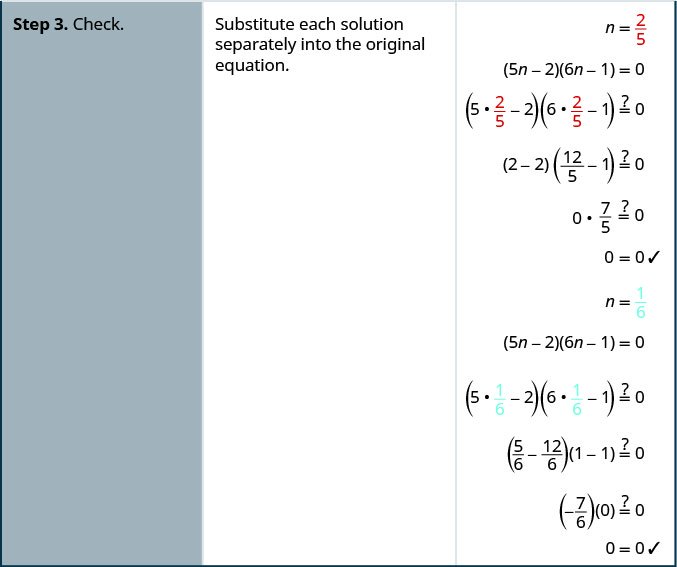
Solve: ![]()
![]()
Solve: ![]()
![]()
- Set each factor equal to zero.
- Solve the linear equations.
- Check.
Solve Quadratic Equations by Factoring
The Zero Product Property works very nicely to solve quadratic equations. The quadratic equation must be factored, with zero isolated on one side. So we be sure to start with the quadratic equation in standard form, ![]() Then we factor the expression on the left.
Then we factor the expression on the left.
Solve: ![]()




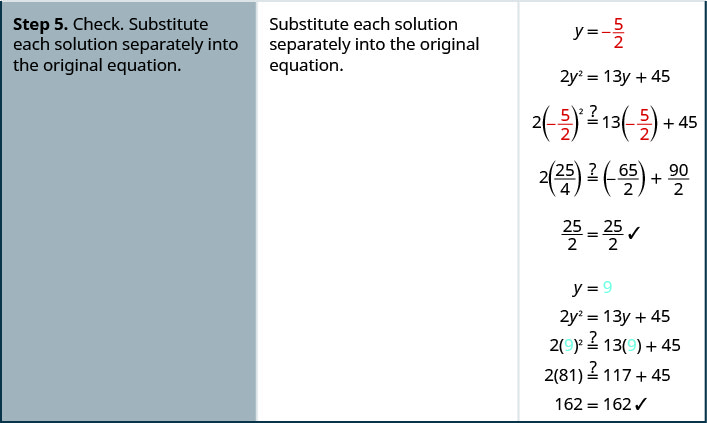
Solve: ![]()
![]()
Solve: ![]()
![]()
- Write the quadratic equation in standard form,

- Factor the quadratic expression.
- Use the Zero Product Property.
- Solve the linear equations.
- Check. Substitute each solution separately into the original equation.
Before we factor, we must make sure the quadratic equation is in standard form.
Solving quadratic equations by factoring will make use of all the factoring techniques you have learned in this chapter! Do you recognize the special product pattern in the next example?
Solve: ![]()

Check:
We leave the check up to you.
Solve: ![]()
![]()
Solve: ![]()
![]()
In the next example, the left side of the equation is factored, but the right side is not zero. In order to use the Zero Product Property, one side of the equation must be zero. We’ll multiply the factors and then write the equation in standard form.
Solve: ![]()

Solve: ![]()
![]()
Solve: ![]()
![]()
In the next example, when we factor the quadratic equation we will get three factors. However the first factor is a constant. We know that factor cannot equal 0.
Solve: ![]()

Solve: ![]()
![]()
Solve: ![]()
![]()
The Zero Product Property also applies to the product of three or more factors. If the product is zero, at least one of the factors must be zero. We can solve some equations of degree greater than two by using the Zero Product Property, just like we solved quadratic equations.
Solve: ![]()

Solve: ![]()
![]()
Solve: ![]()
![]()
Solve Equations with Polynomial Functions
As our study of polynomial functions continues, it will often be important to know when the function will have a certain value or what points lie on the graph of the function. Our work with the Zero Product Property will be help us find these answers.
For the function ![]()
ⓐ find x when ![]()
ⓑ find two points that lie on the graph of the function.
ⓐ
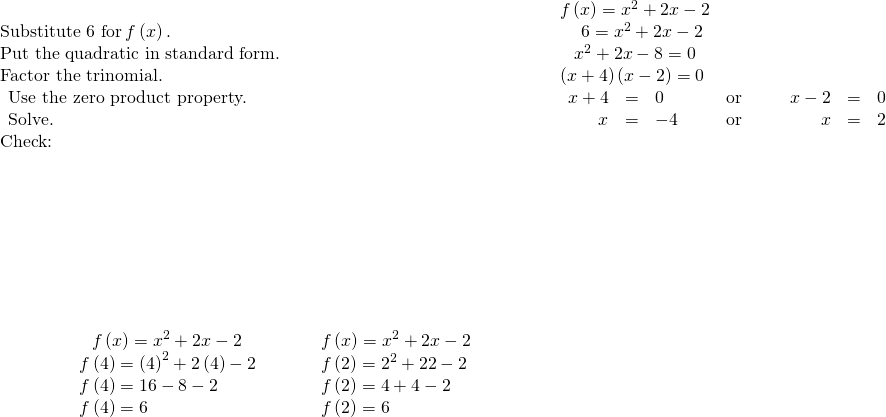
ⓑ Since ![]() and
and ![]() the points
the points ![]() and
and ![]() lie on the graph of the function.
lie on the graph of the function.
For the function ![]()
ⓐ find x when ![]()
ⓑ Find two points that lie on the graph of the function.
ⓐ![]() or
or ![]()
ⓑ ![]()
![]()
For the function ![]()
ⓐ find x when ![]()
ⓑ Find two points that lie on the graph of the function.
ⓐ![]() or
or ![]()
ⓑ ![]()
![]()
The Zero Product Property also helps us determine where the function is zero. A value of x where the function is 0, is called a zero of the function.
For any function f, if ![]() then x is a zero of the function.
then x is a zero of the function.
When ![]() the point
the point ![]() is a point on the graph. This point is an x-intercept of the graph. It is often important to know where the graph of a function crosses the axes. We will see some examples later.
is a point on the graph. This point is an x-intercept of the graph. It is often important to know where the graph of a function crosses the axes. We will see some examples later.
For the function ![]() find
find
ⓐ the zeros of the function,
ⓑ any x-intercepts of the graph of the function
ⓒ any y-intercepts of the graph of the function
ⓐ To find the zeros of the function, we need to find when the function value is 0.

ⓑ An x-intercept occurs when ![]() Since
Since ![]() and
and ![]() the points
the points ![]() and
and ![]() lie on the graph. These points are x-intercepts of the function.
lie on the graph. These points are x-intercepts of the function.
ⓒ A y-intercept occurs when ![]() To find the y-intercepts we need to find
To find the y-intercepts we need to find ![]()

Since ![]() the point
the point ![]() lies on the graph. This point is the y-intercept of the function.
lies on the graph. This point is the y-intercept of the function.
For the function ![]() find
find
ⓐ the zeros of the function
ⓑ any x-intercepts of the graph of the function
ⓒ any y-intercepts of the graph of the function.
ⓐ![]() or
or ![]()
ⓑ ![]()
![]() ⓒ
ⓒ ![]()
For the function ![]() find
find
ⓐ the zeros of the function
ⓑ any x-intercepts of the graph of the function
ⓒ any y-intercepts of the graph of the function.
ⓐ![]() or
or ![]()
ⓑ ![]()
![]() ⓒ
ⓒ ![]()
Solve Applications Modeled by Polynomial Equations
The problem-solving strategy we used earlier for applications that translate to linear equations will work just as well for applications that translate to polynomial equations. We will copy the problem-solving strategy here so we can use it for reference.
- Read the problem. Make sure all the words and ideas are understood.
- Identify what we are looking for.
- Name what we are looking for. Choose a variable to represent that quantity.
- Translate into an equation. It may be helpful to restate the problem in one sentence with all the important information. Then, translate the English sentence into an algebraic equation.
- Solve the equation using appropriate algebra techniques.
- Check the answer in the problem and make sure it makes sense.
- Answer the question with a complete sentence.
We will start with a number problem to get practice translating words into a polynomial equation.
The product of two consecutive odd integers is 323. Find the integers.

There are two values for n that are solutions to this problem. So there are two sets of consecutive odd integers that will work.

The product of two consecutive odd integers is 255. Find the integers.
![]() and 15, 17
and 15, 17
The product of two consecutive odd integers is 483 Find the integers.
![]() and 21, 23
and 21, 23
Were you surprised by the pair of negative integers that is one of the solutions to the previous example? The product of the two positive integers and the product of the two negative integers both give positive results.
In some applications, negative solutions will result from the algebra, but will not be realistic for the situation.
A rectangular bedroom has an area 117 square feet. The length of the bedroom is four feet more than the width. Find the length and width of the bedroom.
| Step 1. Read the problem. In problems involving
geometric figures, a sketch can help you visualize the situation. |
 |
| Step 2. Identify what you are looking for. | We are looking for the length and width. |
| Step 3. Name what you are looking for. | Let |
| The length is four feet more than the width. | |
| Step 4. Translate into an equation. | |
| Restate the important information in a sentence. | The area of the bedroom is 117 square feet. |
| Use the formula for the area of a rectangle. | |
| Substitute in the variables. | |
| Step 5. Solve the equation Distribute first. | |
| Get zero on one side. | |
| Factor the trinomial. | |
| Use the Zero Product Property. | |
| Solve each equation. | |
| Since w is the width of the bedroom, it does not
make sense for it to be negative. We eliminate that value for w. |
|
| Find the value of the length. |
|
| Step 6. Check the answer.
Does the answer make sense?
Yes, this makes sense. |
|
| Step 7. Answer the question. | The width of the bedroom is 9 feet and
the length is 13 feet. |
A rectangular sign has area 30 square feet. The length of the sign is one foot more than the width. Find the length and width of the sign.
The width is 5 feet and length is 6 feet.
A rectangular patio has area 180 square feet. The width of the patio is three feet less than the length. Find the length and width of the patio.
The length of the patio is 12 feet and the width 15 feet.
In the next example, we will use the Pythagorean Theorem ![]() This formula gives the relation between the legs and the hypotenuse of a right triangle.
This formula gives the relation between the legs and the hypotenuse of a right triangle.
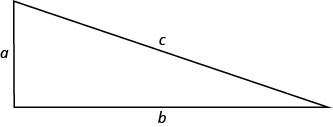
We will use this formula to in the next example.
A boat’s sail is in the shape of a right triangle as shown. The hypotenuse will be 17 feet long. The length of one side will be 7 feet less than the length of the other side. Find the lengths of the sides of the sail.

| Step 1. Read the problem | |
| Step 2. Identify what you are looking for. | We are looking for the lengths of the
sides of the sail. |
| Step 3. Name what you are looking for.
One side is 7 less than the other. |
Let
|
| Step 4. Translate into an equation. Since this is a
right triangle we can use the Pythagorean Theorem. |
|
| Substitute in the variables. | |
| Step 5. Solve the equation
Simplify. |
|
| It is a quadratic equation, so get zero on one side. | |
| Factor the greatest common factor. | |
| Factor the trinomial. | |
| Use the Zero Product Property. | |
| Solve. | |
| Since x is a side of the triangle, make sense. |
|
| Find the length of the other side. | |
| If the length of one side is
then the length of the other side is |

8 is the length of the other side. |
| Step 6. Check the answer in the problem
Do these numbers make sense?
|
|
| Step 7. Answer the question | The sides of the sail are 8, 15 and 17 feet. |
Justine wants to put a deck in the corner of her backyard in the shape of a right triangle. The length of one side of the deck is 7 feet more than the other side. The hypotenuse is 13. Find the lengths of the two sides of the deck.
5 feet and 12 feet
A meditation garden is in the shape of a right triangle, with one leg 7 feet. The length of the hypotenuse is one more than the length of the other leg. Find the lengths of the hypotenuse and the other leg.
24 feet and 25 feet
The next example uses the function that gives the height of an object as a function of time when it is thrown from 80 feet above the ground.
Dennis is going to throw his rubber band ball upward from the top of a campus building. When he throws the rubber band ball from 80 feet above the ground, the function ![]() models the height, h, of the ball above the ground as a function of time, t. Find:
models the height, h, of the ball above the ground as a function of time, t. Find:
ⓐ the zeros of this function which tell us when the ball hits the ground
ⓑ when the ball will be 80 feet above the ground
ⓒ the height of the ball at ![]() seconds.
seconds.
ⓐ The zeros of this function are found by solving ![]() This will tell us when the ball will hit the ground.
This will tell us when the ball will hit the ground.

The result ![]() tells us the ball will hit the ground 5 seconds after it is thrown. Since time cannot be negative, the result
tells us the ball will hit the ground 5 seconds after it is thrown. Since time cannot be negative, the result ![]() is discarded.
is discarded.
ⓑ The ball will be 80 feet above the ground when ![]()

ⓒ To find the height ball at ![]() seconds we find
seconds we find ![]()

Genevieve is going to throw a rock from the top a trail overlooking the ocean. When she throws the rock upward from 160 feet above the ocean, the function ![]() models the height, h, of the rock above the ocean as a function of time, t. Find:
models the height, h, of the rock above the ocean as a function of time, t. Find:
ⓐ the zeros of this function which tell us when the rock will hit the ocean
ⓑ when the rock will be 160 feet above the ocean.
ⓒ the height of the rock at ![]() seconds.
seconds.
ⓐ 5 ⓑ 0;3 ⓒ 196
Calib is going to throw his lucky penny from his balcony on a cruise ship. When he throws the penny upward from 128 feet above the ground, the function ![]() models the height, h, of the penny above the ocean as a function of time, t. Find:
models the height, h, of the penny above the ocean as a function of time, t. Find:
ⓐ the zeros of this function which is when the penny will hit the ocean
ⓑ when the penny will be 128 feet above the ocean.
ⓒ the height the penny will be at ![]() seconds which is when the penny will be at its highest point.
seconds which is when the penny will be at its highest point.
ⓐ 4 ⓑ 0;2 ⓒ 144
Access this online resource for additional instruction and practice with quadratic equations.
Key Concepts
- Polynomial Equation: A polynomial equation is an equation that contains a polynomial expression. The degree of the polynomial equation is the degree of the polynomial.
- Quadratic Equation: An equation of the form
 is called a quadratic equation.
is called a quadratic equation.

- Zero Product Property: If
 then either
then either  or
or  or both.
or both. - How to use the Zero Product Property
- Set each factor equal to zero.
- Solve the linear equations.
- Check.
- How to solve a quadratic equation by factoring.
- Write the quadratic equation in standard form,

- Factor the quadratic expression.
- Use the Zero Product Property.
- Solve the linear equations.
- Check. Substitute each solution separately into the original equation.
- Write the quadratic equation in standard form,
- Zero of a Function: For any function f, if
 then x is a zero of the function.
then x is a zero of the function. - How to use a problem solving strategy to solve word problems.
- Read the problem. Make sure all the words and ideas are understood.
- Identify what we are looking for.
- Name what we are looking for. Choose a variable to represent that quantity.
- Translate into an equation. It may be helpful to restate the problem in one sentence with all the important information. Then, translate the English sentence into an algebraic equation.
- Solve the equation using appropriate algebra techniques.
- Check the answer in the problem and make sure it makes sense.
- Answer the question with a complete sentence.
Section Exercises
Practice Makes Perfect
Use the Zero Product Property
In the following exercises, solve.
![]()
![]()
![]()
![]()
![]()
![]()
![]()
![]()
![]()
Solve Quadratic Equations by Factoring
In the following exercises, solve.
![]()
![]()
![]()
![]()
![]()
![]()
![]()
![]()
![]()
![]()
![]()
![]()
![]()
![]()
![]()
![]()
![]()
![]()
![]()
![]()
![]()
![]()
![]()
![]()
![]()
![]()
![]()
![]()
![]()
![]()
![]()
![]()
![]()
![]()
![]()
![]()
![]()
![]()
![]()
![]()
![]()
![]()
![]()
![]()
![]()
Solve Equations with Polynomial Functions
In the following exercises, solve.
For the function, ![]() ⓐ find when
ⓐ find when ![]() ⓑ Use this information to find two points that lie on the graph of the function.
ⓑ Use this information to find two points that lie on the graph of the function.
ⓐ![]() or
or ![]() ⓑ
ⓑ ![]()
![]()
For the function, ![]() ⓐ find when
ⓐ find when ![]() ⓑ Use this information to find two points that lie on the graph of the function.
ⓑ Use this information to find two points that lie on the graph of the function.
For the function, ![]() ⓐ find when
ⓐ find when ![]() ⓑ Use this information to find two points that lie on the graph of the function.
ⓑ Use this information to find two points that lie on the graph of the function.
ⓐ![]() or
or ![]()
ⓑ ![]()
![]()
For the function, ![]() ⓐ find when
ⓐ find when ![]() ⓑ Use this information to find two points that lie on the graph of the function.
ⓑ Use this information to find two points that lie on the graph of the function.
In the following exercises, for each function, find: ⓐ the zeros of the function ⓑ the x-intercepts of the graph of the function ⓒ the y-intercept of the graph of the function.
![]()
ⓐ![]() or
or ![]()
ⓑ ![]() ,
, ![]() ⓒ
ⓒ ![]()
![]()
![]()
ⓐ![]() or
or ![]()
ⓑ ![]() ,
, ![]() ⓒ
ⓒ ![]()
![]()
Solve Applications Modeled by Quadratic Equations
In the following exercises, solve.
The product of two consecutive odd integers is 143. Find the integers.
![]() and 11, 13
and 11, 13
The product of two consecutive odd integers is 195. Find the integers.
The product of two consecutive even integers is 168. Find the integers.
![]() and 12, 14
and 12, 14
The product of two consecutive even integers is 288. Find the integers.
The area of a rectangular carpet is 28 square feet. The length is three feet more than the width. Find the length and the width of the carpet.
![]() and 7
and 7
A rectangular retaining wall has area 15 square feet. The height of the wall is two feet less than its length. Find the height and the length of the wall.
The area of a bulletin board is 55 square feet. The length is four feet less than three times the width. Find the length and the width of the a bulletin board.
5, 11
A rectangular carport has area 150 square feet. The height of the carport is five feet less than twice its length. Find the height and the length of the carport.
A pennant is shaped like a right triangle, with hypotenuse 10 feet. The length of one side of the pennant is two feet longer than the length of the other side. Find the length of the two sides of the pennant.
6, 8
A stained glass window is shaped like a right triangle. The hypotenuse is 15 feet. One leg is three more than the other. Find the lengths of the legs.
A reflecting pool is shaped like a right triangle, with one leg along the wall of a building. The hypotenuse is 9 feet longer than the side along the building. The third side is 7 feet longer than the side along the building. Find the lengths of all three sides of the reflecting pool.
8, 15, 17
A goat enclosure is in the shape of a right triangle. One leg of the enclosure is built against the side of the barn. The other leg is 4 feet more than the leg against the barn. The hypotenuse is 8 feet more than the leg along the barn. Find the three sides of the goat enclosure.
Juli is going to launch a model rocket in her back yard. When she launches the rocket, the function ![]() models the height, h, of the rocket above the ground as a function of time, t. Find:
models the height, h, of the rocket above the ground as a function of time, t. Find:
ⓐ the zeros of this function which tells us when the rocket will hit the ground. ⓑ the time the rocket will be 16 feet above the ground.
ⓐ 0, 2 ⓑ 1
Gianna is going to throw a ball from the top floor of her middle school. When she throws the ball from 48 feet above the ground, the function ![]() models the height, h, of the ball above the ground as a function of time, t. Find:
models the height, h, of the ball above the ground as a function of time, t. Find:
ⓐ the zeros of this function which tells us when the ball will hit the ground. ⓑ the time(s) the ball will be 48 feet above the ground. ⓒ the height the ball will be at ![]() seconds which is when the ball will be at its highest point.
seconds which is when the ball will be at its highest point.
Writing Exercises
Explain how you solve a quadratic equation. How many answers do you expect to get for a quadratic equation?
Answers will vary.
Give an example of a quadratic equation that has a GCF and none of the solutions to the equation is zero.
Self Check
ⓐ After completing the exercises, use this checklist to evaluate your mastery of the objectives of this section.
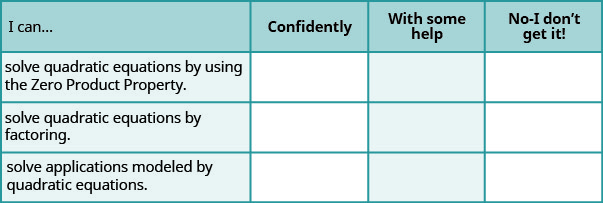
ⓑ Overall, after looking at the checklist, do you think you are well-prepared for the next section? Why or why not?
Chapter Review Exercises
Greatest Common Factor and Factor by Grouping
Find the Greatest Common Factor of Two or More Expressions
In the following exercises, find the greatest common factor.
![]()
![]()
![]()
![]()
![]()
![]()
Factor the Greatest Common Factor from a Polynomial
In the following exercises, factor the greatest common factor from each polynomial.
![]()
![]()
![]()
![]()
![]()
![]()
![]()
![]()
![]()
![]()
![]()
![]()
Factor by Grouping
In the following exercises, factor by grouping.
![]()
![]()
![]()
![]()
![]()
![]()
![]()
![]()
![]()
Factor Trinomials
Factor Trinomials of the Form ![]()
In the following exercises, factor each trinomial of the form ![]()
![]()
![]()
![]()
![]()
![]()
![]()
In the following examples, factor each trinomial of the form ![]()
![]()
![]()
![]()
![]()
![]()
![]()
![]()
Prime
Factor Trinomials of the Form ![]() Using Trial and Error
Using Trial and Error
In the following exercises, factor completely using trial and error.
![]()
![]()
![]()
![]()
![]()
![]()
![]()
![]()
![]()
![]()
![]()
![]()
Factor Trinomials of the Form ![]() using the ‘ac’ Method
using the ‘ac’ Method
In the following exercises, factor.
![]()
![]()
![]()
![]()
![]()
![]()
![]()
![]()
![]()
![]()
![]()
![]()
![]()
Factor using substitution
In the following exercises, factor using substitution.
![]()
![]()
![]()
Factor Special Products
Factor Perfect Square Trinomials
In the following exercises, factor completely using the perfect square trinomials pattern.
![]()
![]()
![]()
![]()
![]()
![]()
![]()
![]()
Factor Differences of Squares
In the following exercises, factor completely using the difference of squares pattern, if possible.
![]()
![]()
![]()
![]()
![]()
![]()
![]()
![]()
![]()
![]()
![]()
![]()
![]()
![]()
![]()
![]()
![]()
![]()
![]()
Factor Sums and Differences of Cubes
In the following exercises, factor completely using the sums and differences of cubes pattern, if possible.
![]()
![]()
![]()
![]()
![]()
![]()
General Strategy for Factoring Polynomials
Recognize and Use the Appropriate Method to Factor a Polynomial Completely
In the following exercises, factor completely.
![]()
![]()
![]()
![]()
![]()
![]()
![]()
![]()
![]()
![]()
prime
![]()
![]()
![]()
![]()
![]()
![]()
![]()
![]()
![]()
![]()
![]()
![]()
![]()
![]()
![]()
Polynomial Equations
Use the Zero Product Property
In the following exercises, solve.
![]()
![]()
![]()
![]()
![]()
![]()
![]()
Solve Quadratic Equations by Factoring
In the following exercises, solve.
![]()
![]()
![]()
![]()
![]()
![]()
![]()
![]()
![]()
![]()
![]()
![]()
![]()
![]()
![]()
Solve Equations with Polynomial Functions
In the following exercises, solve.
For the function, ![]() ⓐ find when
ⓐ find when ![]() ⓑ Use this information to find two points that lie on the graph of the function.
ⓑ Use this information to find two points that lie on the graph of the function.
ⓐ![]() or
or ![]()
ⓑ ![]()
![]()
For the function, ![]() ⓐ find when
ⓐ find when ![]() ⓑ Use this information to find two points that lie on the graph of the function.
ⓑ Use this information to find two points that lie on the graph of the function.
In each function, find: ⓐ the zeros of the function ⓑ the x-intercepts of the graph of the function ⓒ the y-intercept of the graph of the function.
![]()
ⓐ![]() or
or ![]()
ⓑ ![]()
![]() ⓒ
ⓒ ![]()
![]()
Solve Applications Modeled by Quadratic Equations
In the following exercises, solve.
The product of two consecutive numbers is 399. Find the numbers.
The numbers are ![]() and
and ![]() or 19 and 21.
or 19 and 21.
The area of a rectangular shaped patio 432 square feet. The length of the patio is 6 feet more than its width. Find the length and width.
A ladder leans against the wall of a building. The length of the ladder is 9 feet longer than the distance of the bottom of the ladder from the building. The distance of the top of the ladder reaches up the side of the building is 7 feet longer than the distance of the bottom of the ladder from the building. Find the lengths of all three sides of the triangle formed by the ladder leaning against the building.
The lengths are 8, 15, and 17 ft.
Shruti is going to throw a ball from the top of a cliff. When she throws the ball from 80 feet above the ground, the function ![]() models the height, h, of the ball above the ground as a function of time, t. Find: ⓐ the zeros of this function which tells us when the ball will hit the ground. ⓑ the time(s) the ball will be 80 feet above the ground. ⓒ the height the ball will be at
models the height, h, of the ball above the ground as a function of time, t. Find: ⓐ the zeros of this function which tells us when the ball will hit the ground. ⓑ the time(s) the ball will be 80 feet above the ground. ⓒ the height the ball will be at ![]() seconds which is when the ball will be at its highest point.
seconds which is when the ball will be at its highest point.
Chapter Practice Test
In the following exercises, factor completely.
![]()
![]()
![]()
![]()
![]()
![]()
![]()
![]()
![]()
![]()
![]()
![]()
![]()
![]()
![]()
![]()
![]()
![]()
![]()
![]()
![]()
In the following exercises, solve
![]()
![]()
The product of two consecutive integers is 156. Find the integers.
The area of a rectangular place mat is 168 square inches. Its length is two inches longer than the width. Find the length and width of the placemat.
The width is 12 inches and the length is 14 inches.
Jing is going to throw a ball from the balcony of her condo. When she throws the ball from 80 feet above the ground, the function ![]() models the height, h, of the ball above the ground as a function of time, t. Find: ⓐ the zeros of this function which tells us when the ball will hit the ground. ⓑ the time(s) the ball will be 128 feet above the ground. ⓒ the height the ball will be at
models the height, h, of the ball above the ground as a function of time, t. Find: ⓐ the zeros of this function which tells us when the ball will hit the ground. ⓑ the time(s) the ball will be 128 feet above the ground. ⓒ the height the ball will be at ![]() seconds.
seconds.
For the function, ![]() ⓐ find when
ⓐ find when ![]() ⓑ Use this information to find two points that lie on the graph of the function.
ⓑ Use this information to find two points that lie on the graph of the function.
ⓐ![]() or
or ![]() ⓑ
ⓑ ![]()
![]()
For the function ![]() find: ⓐ the zeros of the function ⓑ the x-intercepts of the graph of the function ⓒ the y-intercept of the graph of the function.
find: ⓐ the zeros of the function ⓑ the x-intercepts of the graph of the function ⓒ the y-intercept of the graph of the function.
Glossary
- degree of the polynomial equation
- The degree of the polynomial equation is the degree of the polynomial.
- polynomial equation
- A polynomial equation is an equation that contains a polynomial expression.
- quadratic equation
- Polynomial equations of degree two are called quadratic equations.
- zero of the function
- A value of
 where the function is 0, is called a zero of the function.
where the function is 0, is called a zero of the function.
- Zero Product Property
- The Zero Product Property says that if the product of two quantities is zero, then at least one of the quantities is zero.

